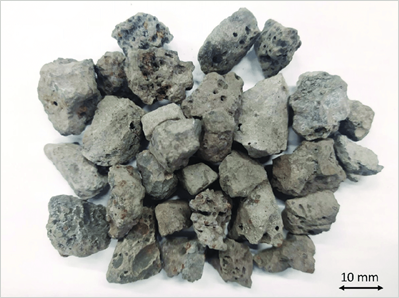In terms of cement technological considerations, EAF-slag is predominantly classified as inert, so that in most cases only a small contribution to strength development can be attributed to EAF-slag (Ehrenberg, 2009). Adding 5-10 % EAF-slag to Ordinary Portland Cement can result in a strength development that is comparable to that of Ordinary Portland Cement (Tao et al. 2020).
Chemical analyses of EAF-slags produced worldwide show CaO contents between 16.9 and 50.0%. The magnesium oxide contents range from ~1.5 to 14.0% (Tao et al., 2020). Theoretically, CO₂ can be permanently bound by recarbonation of the oxidically bound mineral phases, which essentially means CaO and MgO. The maximum amount of CO₂ that can be reabsorbed is the CO₂ content emitted during the production of the EAF-slag. Investigations show that it is generally possible to incorporate CO₂ during the grinding of EAF-slag. Due to the generation of high finenesses and new specific surfaces during grinding, a sufficiently high reaction rate can be expected, but cannot yet be quantified more precisely. The boundary conditions (temperature, residence time, etc.) are also still unknown and therefore need to be investigated. EAF-slags could therefore be used in cement and concrete in the future in a climate-neutral way by means of comminution and simultaneously CO₂ binding. Studies show that wet grinding of EAF-slags with the induction of gaseous CO₂ can absorb part of the greenhouse gas. Compared to typical dry grinding - as is commonly used in the cement industry - the recarbonisation effect is considerably higher with wet grinding than in direct comparison to dry grinding (Kurusta et al., 2023; Yokoyama et al., 2010).

